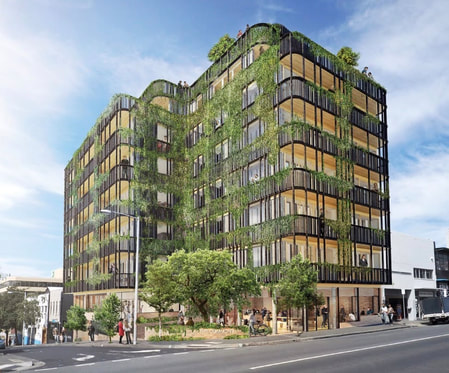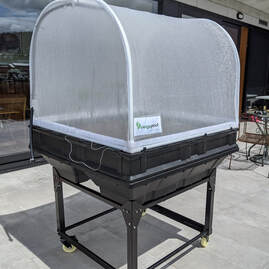Growing green walls and vegetables

A Gardening and Green Wall Working Group has been set up to oversight management of the community's common area gardens and the building's Green Wall. Managing the Green Wall includes distribution of dedicated planter boxes, and ongoing maintenance of evergreen plants on most of the balconied walls of the building.
A shared rooftop veggie patch is available to grow extra food either for personal use or to share with The Commons community. Our veggie patch team meets regularly to plant and weed together. Biofilta Food Cubes are being used in order to ensure efficient water use - these are sturdy wicking beds with large waterwells.
In addition, all apartments have generous sunlit balconies, so many of us are enthusiastically getting into individual gardening on our own decks.
A shared rooftop veggie patch is available to grow extra food either for personal use or to share with The Commons community. Our veggie patch team meets regularly to plant and weed together. Biofilta Food Cubes are being used in order to ensure efficient water use - these are sturdy wicking beds with large waterwells.
In addition, all apartments have generous sunlit balconies, so many of us are enthusiastically getting into individual gardening on our own decks.
Composting and minimizing waste
The Commons has a worm farm and a couple of rotating compost bins. We also minimize waste through our Recycling Centre and our own internal "street library". Residents can "rehome" longer wanted household goods via the 'good karma' channel in our internal Slack forum.
Tips for terrace gardening

Moving into an apartment has been a new thing for many of us, and we are learning a lot on our individual journeys to happy productive balcony gardening. We are learning heaps about growing in pots, including that Pot Feet are essential for good drainage (who knew?).
Plants in pots can dry out very quickly
Irrigation, using a timer on a tap on the balcony is the best strategy to deal with this. We are using timed drip irrigation on many of our Green Wall planters.
Waterwell planters are an efficient way to provide a reservoir of water within reach of the roots. Plants will need daily watering until they have grown sufficiently that their roots can reach the reservoir, after that you can reduce your frequency of watering.
Designs are being improved all the time, and residents are finding options in quite a wide range of sizes and shapes.
The StoneArt egg planter is an example of a quality off-the-shelf waterwell planter that is lightweight.
There are some cheaper options about, such as the HomeLeisure WaterSaver series. These are made from recycled plastic.
Wicking beds are a great solution. With this method, channels of soil reach down into a generous waterwell, and water “wicks” up these channels into the soil mass. You can make your own, or these days there are some excellent options available off the shelf. http://foodgardengroup.blogspot.com/2016/08/how-to-build-wicking-bed.html
Note: the soil depth should be no deeper than 30-35 cm, in order that the water can travel up through the soil. Wicking beds are only suitable for shallow rooted plants - trees with tap roots will penetrate and destroy the reservoir construction.
Vegepod units
These provide good protection from the elements and are excellent for starting seedlings and for shallow rooted plants. They are 1000 mm square, and come with an optional stand, optional wheels, and fibreglass cloth shade house frame. The soil depth is 300mm. https://vegepod.com.au/ In Hobart - available via Teros and Chandlers.
Biofilta Food Cube units
These are sturdy vegetable beds made in Melbourne from recycled plastic. They are self watering, wicking beds and include a water level indicator and drainage outlet, and irrigation connections. Dimensions: 1150 mm square, 500 mm H. Holds 300 L compost. Depth of soil: 315 mm. Area of soil for growing: 1 sq m Water reservoir: 110 L
https://www.biofilta.com.au/foodcube-wicking-bed.html#/
Biofilta Food Cube Slim - 600 mm D, 500 mmH, 1150 mm L.
Accessories are available, such as a central trellis frame, and a framework for shadecloth (via slots in the corners).
Look for a local supplier – here in Hobart the Biofilta Food Cubes are available through Replas, 223 Harrington Street.
A DIY solution for a windbreak/shade screen is the Ezyfix set of popy pipes, connectors and clips, available at Bunnings.
What to grow
Wendy Siu-Chew Lee gives some good tips on what types of plants to grow in containers:
https://www.abc.net.au/gardening/factsheets/balcony-bounty/12801774
She recommends
Plants in pots can dry out very quickly
Irrigation, using a timer on a tap on the balcony is the best strategy to deal with this. We are using timed drip irrigation on many of our Green Wall planters.
Waterwell planters are an efficient way to provide a reservoir of water within reach of the roots. Plants will need daily watering until they have grown sufficiently that their roots can reach the reservoir, after that you can reduce your frequency of watering.
Designs are being improved all the time, and residents are finding options in quite a wide range of sizes and shapes.
The StoneArt egg planter is an example of a quality off-the-shelf waterwell planter that is lightweight.
There are some cheaper options about, such as the HomeLeisure WaterSaver series. These are made from recycled plastic.
Wicking beds are a great solution. With this method, channels of soil reach down into a generous waterwell, and water “wicks” up these channels into the soil mass. You can make your own, or these days there are some excellent options available off the shelf. http://foodgardengroup.blogspot.com/2016/08/how-to-build-wicking-bed.html
Note: the soil depth should be no deeper than 30-35 cm, in order that the water can travel up through the soil. Wicking beds are only suitable for shallow rooted plants - trees with tap roots will penetrate and destroy the reservoir construction.
Vegepod units
These provide good protection from the elements and are excellent for starting seedlings and for shallow rooted plants. They are 1000 mm square, and come with an optional stand, optional wheels, and fibreglass cloth shade house frame. The soil depth is 300mm. https://vegepod.com.au/ In Hobart - available via Teros and Chandlers.
Biofilta Food Cube units
These are sturdy vegetable beds made in Melbourne from recycled plastic. They are self watering, wicking beds and include a water level indicator and drainage outlet, and irrigation connections. Dimensions: 1150 mm square, 500 mm H. Holds 300 L compost. Depth of soil: 315 mm. Area of soil for growing: 1 sq m Water reservoir: 110 L
https://www.biofilta.com.au/foodcube-wicking-bed.html#/
Biofilta Food Cube Slim - 600 mm D, 500 mmH, 1150 mm L.
Accessories are available, such as a central trellis frame, and a framework for shadecloth (via slots in the corners).
Look for a local supplier – here in Hobart the Biofilta Food Cubes are available through Replas, 223 Harrington Street.
A DIY solution for a windbreak/shade screen is the Ezyfix set of popy pipes, connectors and clips, available at Bunnings.
What to grow
Wendy Siu-Chew Lee gives some good tips on what types of plants to grow in containers:
https://www.abc.net.au/gardening/factsheets/balcony-bounty/12801774
She recommends
- cos lettuce, bok choy, broad beans, broccoli, blueberry, snow peas, and grapes.
- With perennials and decorative plants – consider ones that bees love, to attract them to your garden for pollination.
- Trees should be shallow rooted, for fruit trees – select dwarf varieties, and think about espalier options.
- Use good quality potting mix.
- Mulching to protect the soil against hot sun and wind.
- Vertical planting – up a lattice or fence – effectively increases the size of your garden and can provide shade or wind protection for other crops.
- Companion planting maximises plant happiness.
- Deeply renovating or completely replacing the soil in pots is recommended on an annual basis. The tired soil can be donated to a friend’s large garden, there to be revitalised and recirculated.
Proudly powered by Weebly
